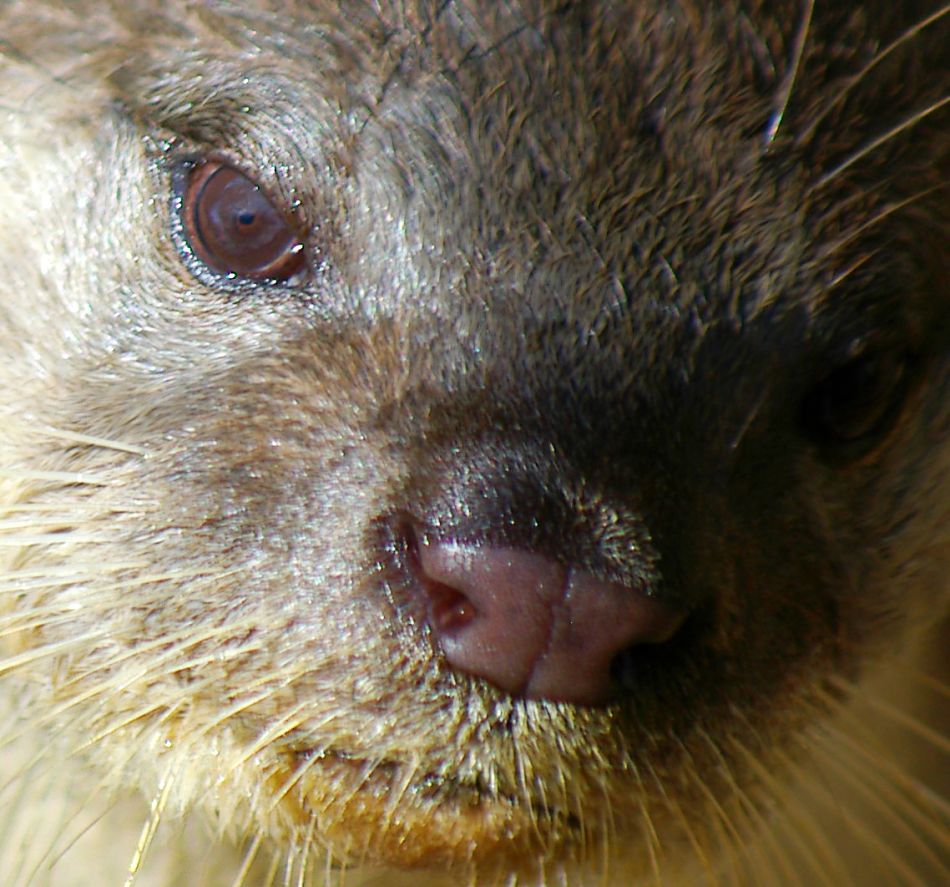otter Facts
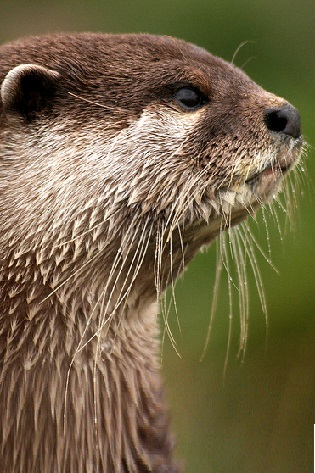 Portrait of a River Otter
Portrait of a River OtterThe coolest of all otter facts is that they use tools to crack open the shells of crabs and clams. Furry, playful and very, very smart, otters are beloved for their adorable antics and sweet appearance. Otters regularly engage in many activities that appear to be positively precious, for instance, sea otters may hold eachothers hand to keep from floating away from eachother.
They will also wrap themselves in seaweed for the same reason. And river otters love to play on slippery rocks or ideally, snow banks, which they will body-surf down the length of, running back up to the top to do it all again. Their antics appear on memes, go viral, and can definitely make you smile, but looks can be deceiving.
Otters are members of the mustilid, or weasel family which includes skunks, wolverines and the honey badger, an animal considered to be one of the toughest creatures on Earth.
Otters are tough as nails too, and well known by zoo curators and wildlife specialists to be dangerous to handle. They are true carnivores, and have powerful jaws that can crack open clam shells with large, curved canine teeth for snagging salmon. Sea otters even have retractable claws on their front feet, which keeps them particularly sharp.
There are 12 species of otters, (13 until the Japanese river otter was declared extinct in only 2012), found all over the world except Australia and Antarctica.
Some are almost exclusively aquatic, like the sea otters that live in the Pacific ocean, and some spend more than half their time on land, like the giant otter that lives in the tropical rain-forests of South America. They all eat fish, clams, lobsters and small animals occurring along the shore. Giant otters regularly feed on piranha, and have also been known to take down alligators.
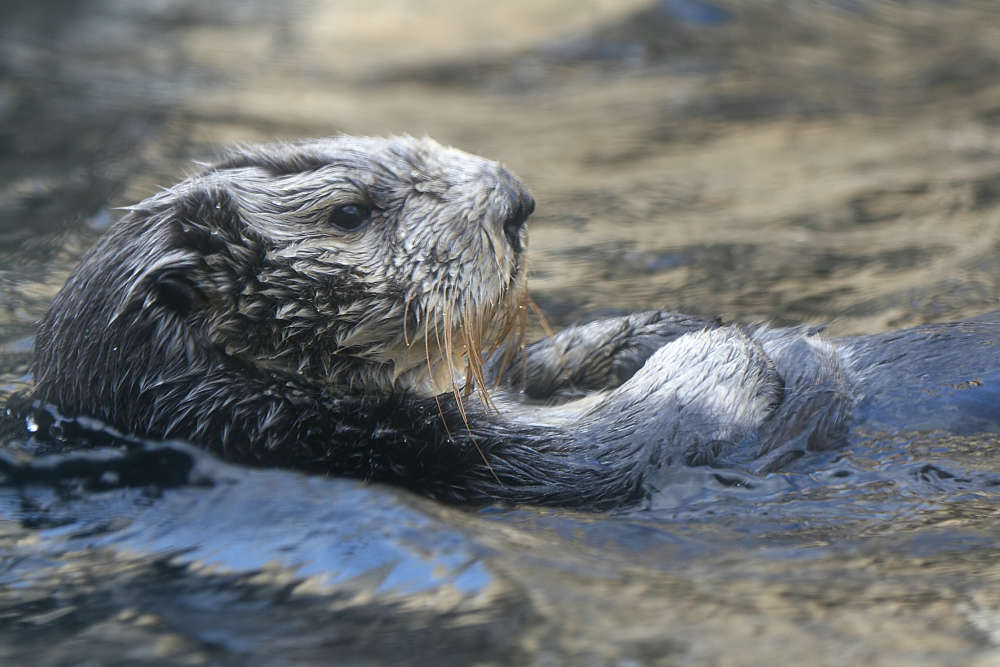 sea otter
sea otterThe smallest otter species is the oriental or Asian small-clawed otter, a beautiful, expressive little otter that doesn't weigh much more than 10 pounds or so. Small-clawed otters live in family groups of 6 to 12 individuals. They have, as the name suggests, small nails on their paws that are shorter than the length of the digits. They are found in wetlands and along lake and river banks throughout the south of Asia, but their numbers are dwindling as habitat is lost.
The European otter, also known as the Eurasian otter, or the common otter, has the widest range of all otter species. They tend to be more adaptable than other otter species, and can survive on a large assortment of foods from fish to crab to muskrats and young beavers. They can be found throughout all of Europe, many areas of Asia, and some territories in northern Africa too. These otters are basically solitary, and very territorial. They are active both day and night hunting both in and out of the water.
The giant otter is the longest of the otters, sometimes reaching 7 feet from nose to tail, and weighing up to 85 pounds, but sea otters are much stouter and large male sea otters in particular are bulkier and heavier than giant otters. Giant otters are the most social of the otter species and have a lifestyle that is somewhat similar to wolves in that the group has an Alpha pair that are the only members who mate and reproduce. They also hunt in packs like wolves and have been known to kill and eat caiman, monkeys and anacondas, but fish is their main meal.
The North American river otter is a medium sized otter about 3 to 4 feet long from nose to tail and weighing up to 40 pounds. They usually live in small groups, but may be solitary as well. These otters eat a variety of fish, invertebrates and small mammals including the occasional rabbit. They are notorious for body surfing down snowy hills.
The sea otter is the heaviest of the otter species with large males weighing as much as 100 pounds. They are marine mammals, existing almost exclusively in the Pacific Ocean, and rarely coming ashore. They float on their backs with their feet out of the water, and dine on shellfish while using their bellies as plates.
Sea otters use rocks obtained from the ocean floor as little anvils they can crack clams open with. This tool use involves the selection of a suitable rock, and the storing of it in the loose skin under the forelimbs. Storing the tool while diving or resting is particularly intriguing evidence of intelligence, suggesting a bit of long term planning - very smart!
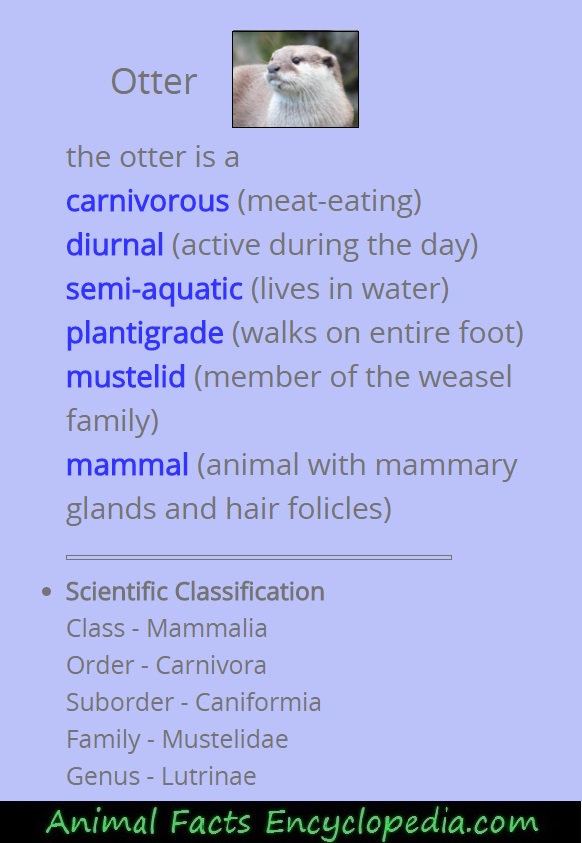
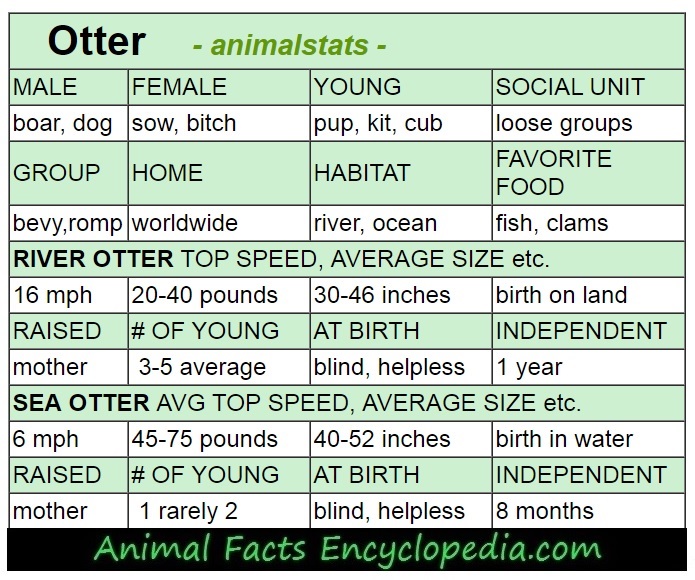
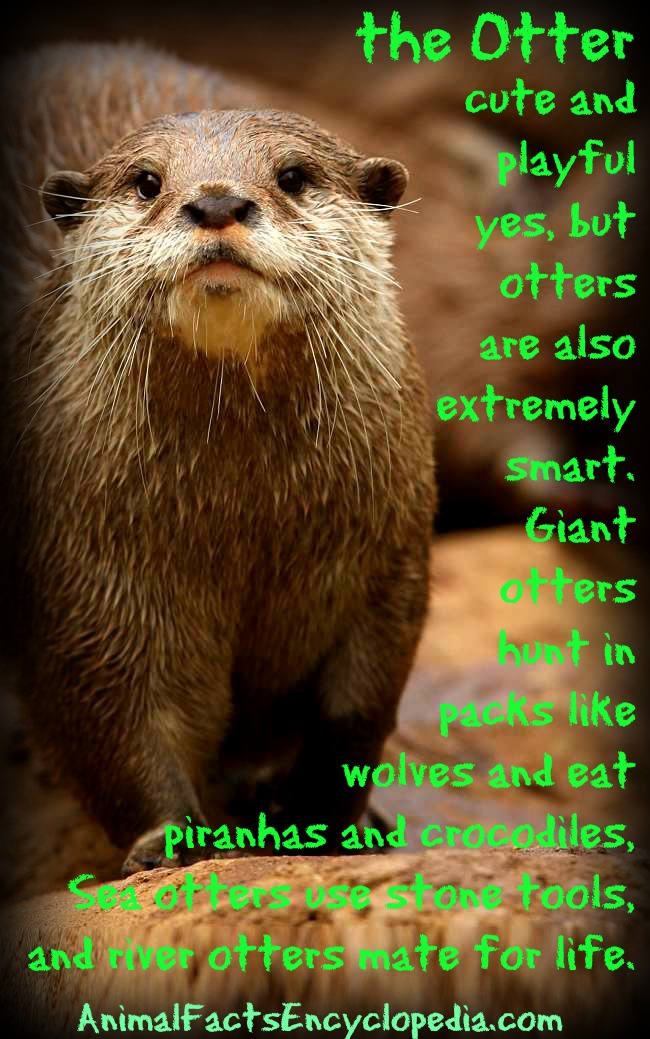
river otter facts
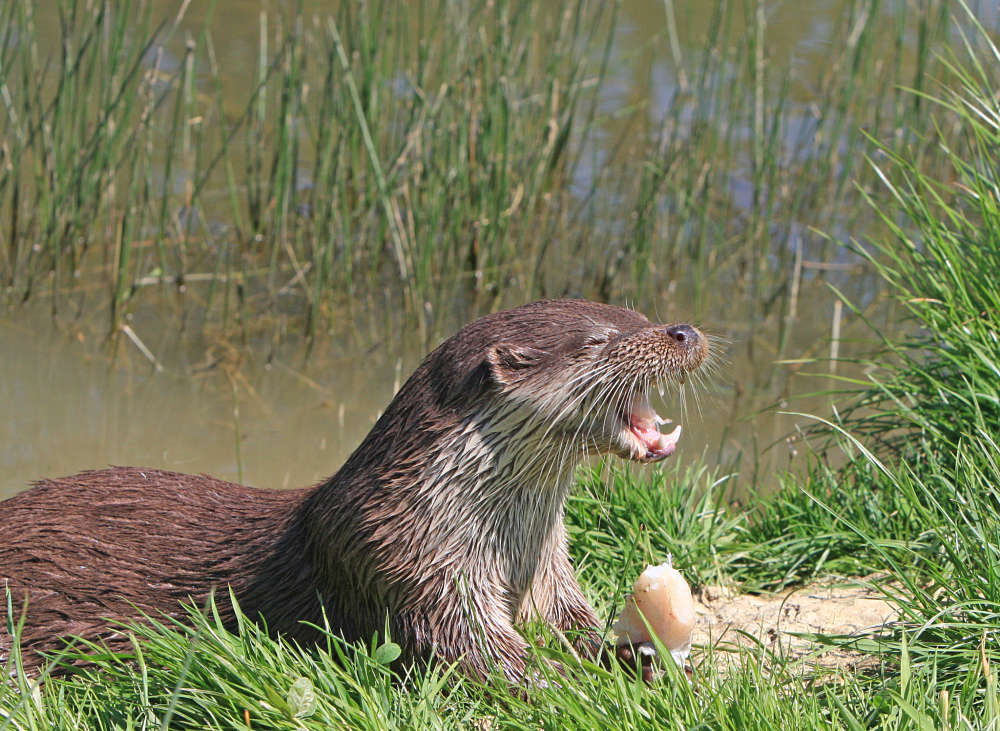
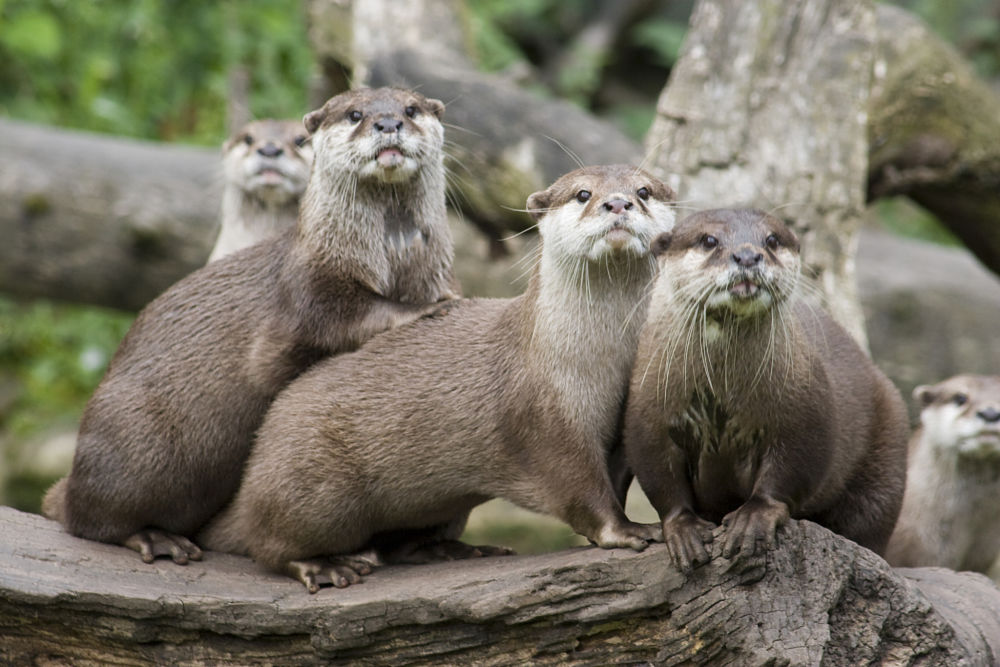
River otters are long-bodied, well-muscled animals, with relatively short legs, five webbed toes on all four feet, (most carnivores have 4 toes on the rear foot), and a long flat tail used as a rudder in the water. The head is broad and somewhat flat with small ears and a powerful, well defined muzzle framed by very long, highly sensitive whiskers, called vibrissae.
The river otter is agile in water and on land, in fact there are two different names for a group of otters - a raft of otters if they are in the water, and a romp of otters if they are on land. They swim using their webbed paws as flippers, and for added speed they will undulate the torso like a dolphin. On land they use a rolling gait like a horses canter, or hop-like movements. They can climb rocky areas and steep shorelines fairly well, and they will regularly slide down appropriate surfaces as a happy short cut.
Although some species of river otters are solitary, most are social, playing, sleeping, and sometimes even hunting together. They require a permanent water source and maintain territories of a few square miles revolving around a lake or river. Some species are very territorial and mark the perimeter of their territory with piles of scat, called spraint.
Many of the river otter species look alike with medium brown fur and similar shaped heads and faces. The giant otters however, are fairly distinctive, with noticeably darker fur that looks almost black when wet, and a unique, round head shape. The muzzle is much more blunted, and the eyes sometimes have a bulging appearance. The giant otter has an unusual nose as well, because it is furred and looks almost like the nose of a monkey.
All river otters are designed for semi-aquatic life. Most have webbed toes, but all have incredibly dense fur that has water-shedding qualities, and is still used to make coats, boot and glove linings, and hats.
Most river otter species are in danger because of their need for a specific habitat. As human encroachment increases, they may all suffer the fate of the recently extinct Japanese river otter. Once numerous, but last seen in the wild in 1979, the Japanese river otter was officially declared extinct in 2012 by the Japanese Ministry of Environment.
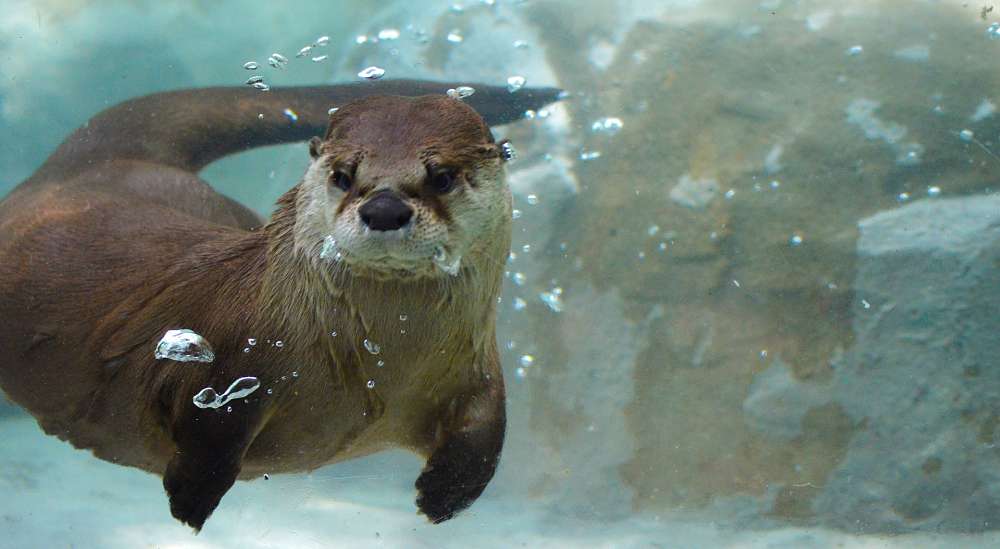
river otter lifestyle
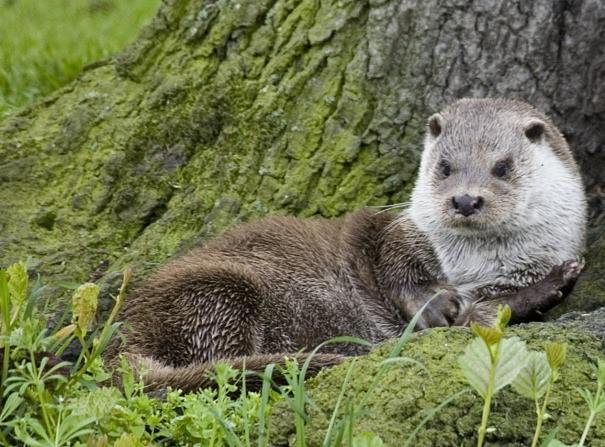
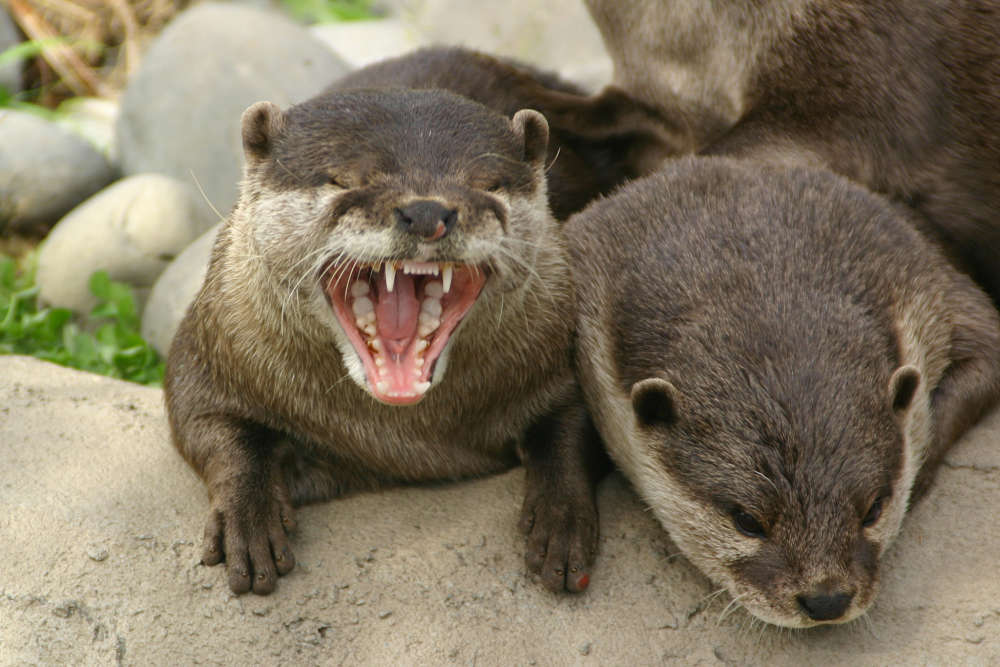
River otters spend equal amounts of time on land and water, and will build a den, called a holt, on the banks, or sometimes in the middle of their lake or stream. Holts may be a burrow, dug directly into the ground, with several entrances, and exits both underwater and on land, or converted beaver dens that otters may add their own flair to. Some holts are caves or stone outcroppings that the otters will partially enclose with a collection of sticks.
Depending on what food is available, otters may forage across a territory of several square miles, eating any small animals within their grasp, from baby bunnies, to insects and grubs, to frogs, snakes and turtles. They will often forage alone, but sometimes hunt in groups, and have been known to attack animals larger than themselves if the numbers are on their side. This was discovered by the Bronx zoo recently, when a group of otters swarmed on a monkey that was being housed in the same exhibit. The otters worked as one swift and merciless unit, and displayed a bit of frenzy behavior.
Giant river otters are the most social of the species, and display the most organized cooperative lifestyle. They live in a pack-like community, with an Alpha pair, their offspring, and assorted relatives, and go out hunting as a group, taking down animals like small deer and rabbits, but also dangerous stuff like anacondas and caiman.
River otters are extremely playful and engage in lots of social bonding, mutual grooming, wrestling and snuggling. The whole family may take part in the rearing of young. Most river otter species are generally monogamous and they may even mate for life.
Females give birth to 2 to 6 babies called pups, that are well-furred, but otherwise helpless with closed eyes and ears. They stay in the den with their mother for several weeks, during which time she may be brought food by family members, and some trusted assistants may even babysit while the mother goes out for a bit of fresh air.
The pups eyes will open at about 4 weeks, and they will begin venturing out of the den at 6 to 10 weeks. River otter mothers have been known to push or drop their youngsters in the water to teach them to swim, which comes naturally of course. Most baby otters are fishing on their own by about 4 months, but they will stay with mom for at least a year.
Some young otters will remain with their romp for life, others will head out on their own when they are between 1 and 4 years old to establish a territory.
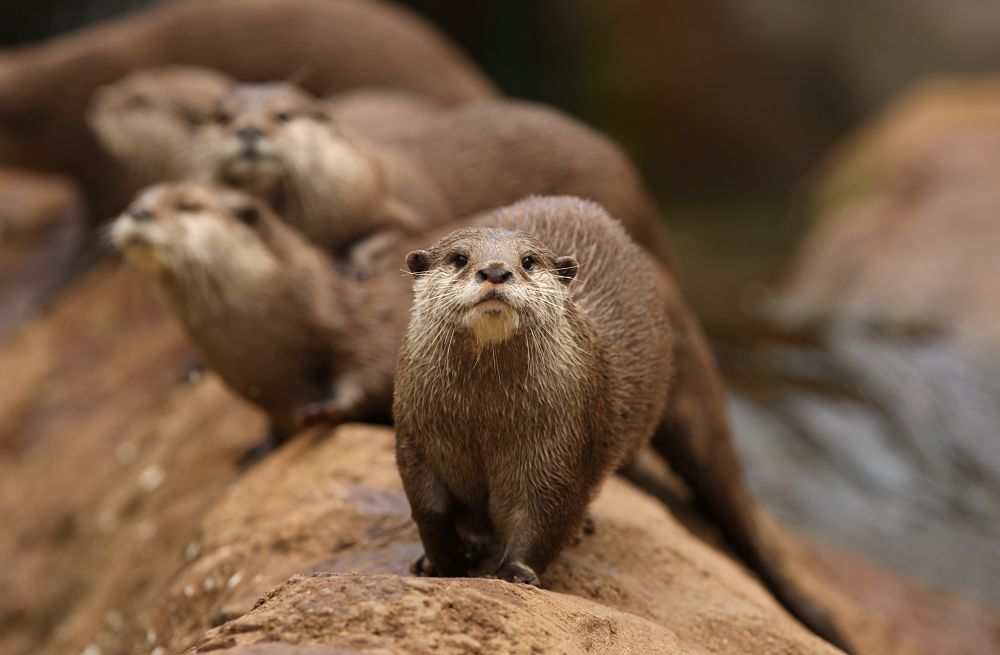
Sea otter facts
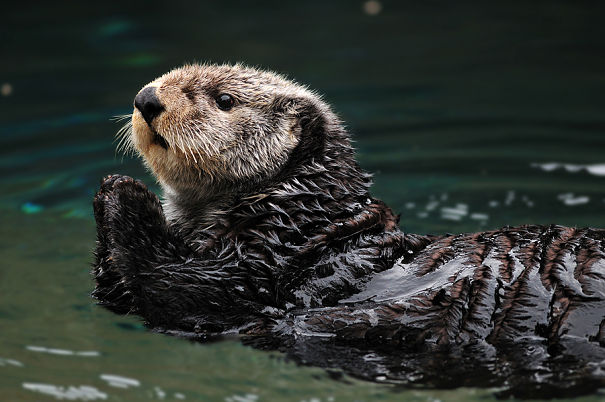
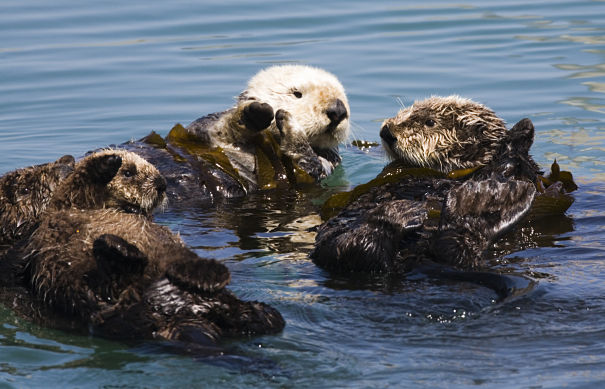
There is one species of sea otter and three subspecies, the California or Southern sea otter is found off the central coast of California, the Northern sea otter is found in the waters off Alaska and Canada, and the common or Asian sea otter is found along coastlines of Japan and Russia.
Although giant otters can be quite a bit longer, sea otters are far bulkier, heavier and ultimately largest species of otter. They are actually the largest member of the weasel, or mustelid family, but they are considered the smallest marine mammal. They can spend almost their entire lives in ocean waters, rarely coming onshore. They sleep, eat, mate and give birth in the water.
Sea otters don't venture far from shore, and spend their days diving to the ocean floor to scrounge up any number of different sea creatures. They prefer clams, mollusks and crab, using their muzzle full of sensitive whiskers and their dexterous, retractable claws to search through coral and kelp.
They take dives an average of 90 seconds long, but can stay under for over 4 minutes. They can store a few food items and rocks in the loose skin under their forelimbs that form pseudo-pouches, tucking away as many as a dozen clams or other small items.
When they surface, they float on their backs and use their belly as a lunch counter. They empty their pouches and pile their clams and crawfish on their chest, pull out a rock they picked out of the sediment, and proceed to grasp each shellfish with their front paws, bashing it against the rock to open it.
Sea otters are perfectly designed for life in chilly, sometimes frigid water, and they exist in some of the coldest regions of the world, spending over 90% of their lives in the desperately cold ocean. They have the densest, basically warmest fur of any mammal, including their relative the mink, but the fur must be kept meticulously clean in order to do its job.
The one-million-hairs-per-square-inch coat keeps them warm with its own thickness, but also serves to trap a layer of air between it and the otters skin, acting like a puffed-up parka and a life jacket at the same time. The insulation only works if the fur is clean, straight and free of any foreign material so the otter spends about 1/3 of its life grooming, but its a matter of life and death. If the fur gets dirty, the otter won't float, and will loose body heat. A sea otter that has been soiled in an oil spill will die without intervention.
This incredible fur almost led to the near extinction of the sea otter, which was hunted down to only a few colonies. Fortunately, Russia, Japan, Canada and the U.S. signed a treaty to ban the hunting of sea otters and fur seals in 1911, and the recovery of the species has been, for the most part, a success.
Sea otters are a little like seals in that they may be found in very large groups, floating in the water in what is called a "raft of otters", but don't have particularly close relationships, or friendships.
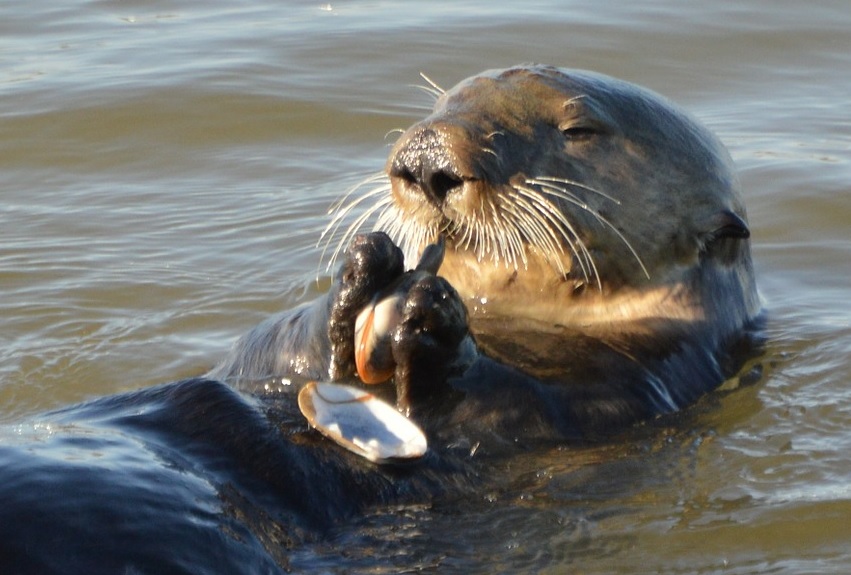 sea otter eating clam diner
sea otter eating clam dinersea otter reproduction
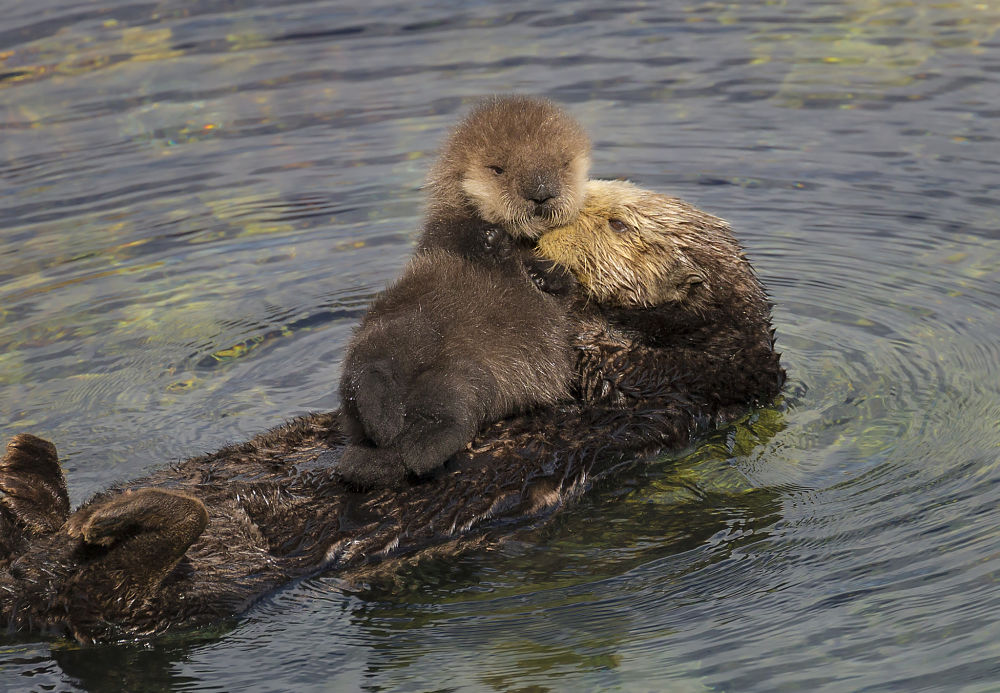
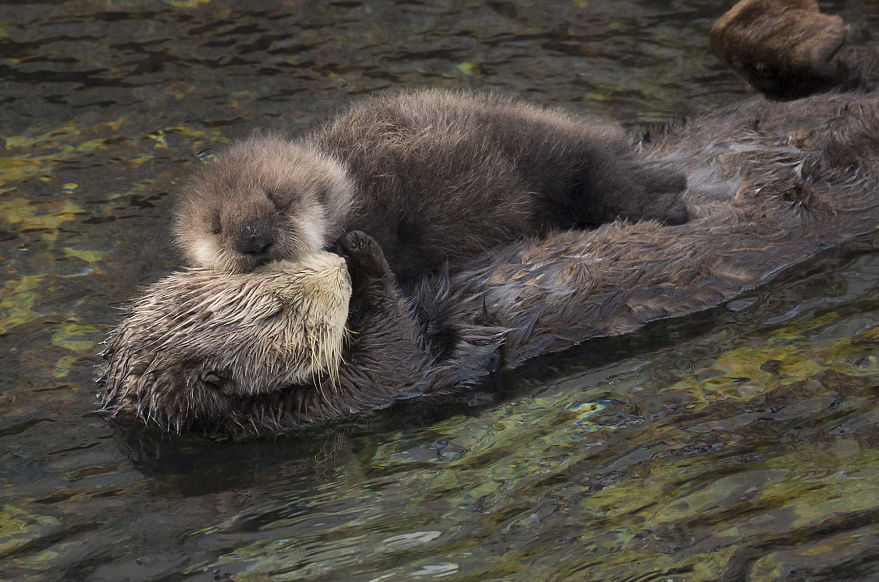
Male and female sea otters generally live in separate groups and come together during mating. Dominant male sea otters claim territories and defend them from younger, older, or less aggressive males. The dominant males will mate with all the females in their territory, and sometimes try to steal or lure females away from other males.
Mating itself is often forced on females. Male otters will bite and hold females by the face or nose in order to mate with them, and researchers actually identify some female sea otters by the scars they have received from violent males.
The female is pregnant for about 4 months and gives birth in the water. Baby sea otters are born quite precocious, or well-developed. They are fully furred have eyes and ears open and are fairly active shortly after birth. The babies fur is a different texture from the adult coat, and the mother pays special attention to grooming the newborn, pulling the fur away from the body and fluffing it out.
The fluffy baby fur is designed to trap air, and once fully groomed by the mother, the newborn baby otter will actually float on the surface of the water, essentially unable to drown, but also unable to swim or dive. The mother will leave the baby on the surface while she dives for food, often safely tucked in a bed of floating kelp. Some mother sea otters have also been observed hoisting their babies up on boat decks or docks to rest while they dive.
It takes 12 to 14 weeks for the adult fur to grow in, the last 2 to 3 weeks of which time the baby slowly loses its extreme buoyancy, and begins to experiment with diving and foraging itself.
The sea otters unique feeding style and fascinating tool use are passed down from mother to baby. Babies are taught to choose stones from the ocean floor that are the appropriate size - large enough to be used as an anvil, small enough to be tucked under the arm and carried to the surface. Otters may also use stones at the ocean floor to knock abalone and other crustaceans free from coral beds.
Mothers teach babies the proper selection of food items as well, and will even hunt and forage in areas with smaller creatures that the baby can manipulate, even though the mother otter would prefer larger prey.
Tool use in sea otters extends beyond stones. They use kelp to prevent themselves and their babies from drifting in the currents, and they also wrap crabs up in kelp to keep them from escaping.
All of these behaviors are passed down from mother to baby, and different uses and preferences for tools can be seen among different populations. It takes a long time to teach all this to a baby otter, and they don't have all the knowledge they need to survive until they are 6 to 8 months old.
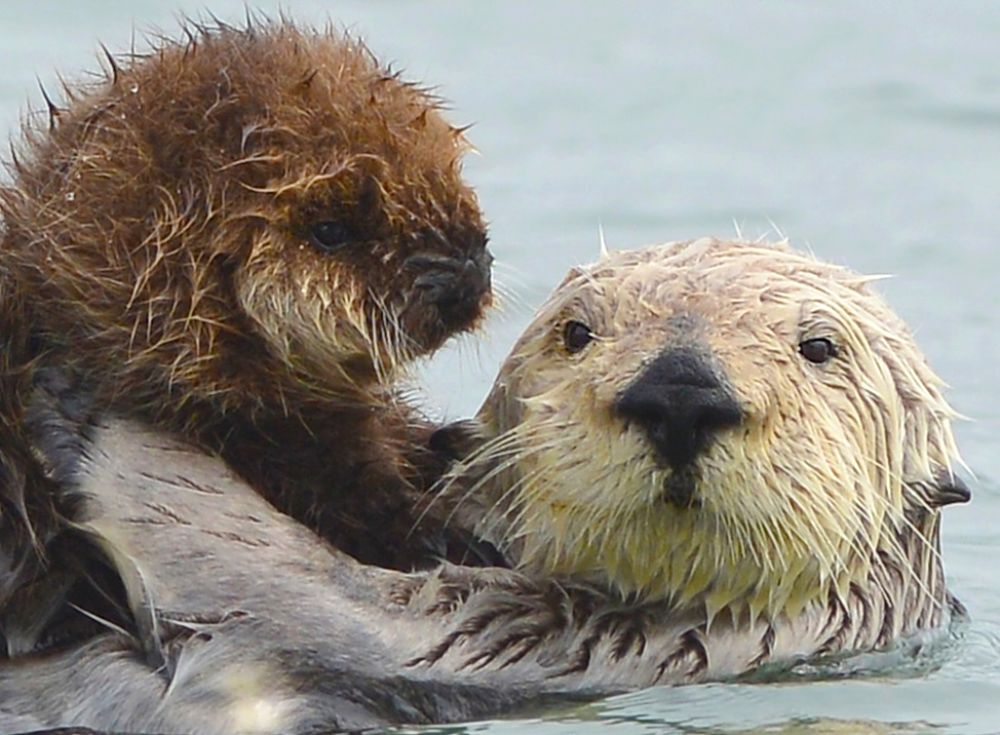 sea otter mother and baby
sea otter mother and baby
do otters rape?
Sea otters have violent mating rituals during which males aggressively assault females, holding their heads underwater, biting their faces and forcing them to submit. The primary injuries are usually to the muzzle and nose of the female, which the male will bite and hold onto. The nosepad, in some cases, is bitten off, or left hanging, and death may result from that injury, or injuries to the head and neck.
In some reports it is suspected that up to 15% of all female otter deaths are the result of injuries sustained during mating. Is the sea otter lifestyle a culture of rape? Well mating is designed to increase the population, not reduce it, and from the male otters standpoint, what would the advantage of killing a female who might otherwise bear your legacy?
This behavior has been a part of their existence since as long as they have been studied by naturalists, and does not seem to be leaving the gene pool, although it would seem that less violent males should be reproducing at a higher rate.
sea otters, interspecies rape and necrophilia
So we learned that the cuddliest of creatures, the sea otter, has a violent sex-life, but it gets worse.
Male sea otters sometimes look outside their own species to inflict themselves on other animals. Reports, eye-witness verification, scientific studies and photographic and video evidence all substantiate numerous cases of male sea otters raping baby seals. This is not a new phenomenon, the evidence has been around for decades.
In these cases, actual penetration occurs, either anal or vaginal, and has caused serious and fatal injury. Sometimes the otters deliberately cause the death of the seal by drowning or repeated bites. There are reports that similar attacks have been committed on seabirds like cormorants, and even one case believed to be quite legitimate, of a dog being the victim.
Interspecies sexual relations are not uncommon, and hybrid animals are the result - like mules or ligers, but a degree of consent is generally required.
Take this one step further to reports that if the baby seal dies during the attack, the sea otter will keep the body and continue to copulate with it for up to a week after the death.
Attacks like this occur generally within the California sea otter population. In one two year period between 2000 and 2002, 19 separate sexual interactions were recorded between male sea otters and immature seals in Monterey Bay alone. None have been reported among Alaskan sea otters.
In the case of the dog attack, the otter was seen swimming about with the dead dog grasped between its front limbs, all the while copulating with it, as other dogs on shore barked and whined.
The explanation may lie in the fact that otters are polygynous, meaning only a few dominant males mate with the majority of females, leaving allot of frustrated boys to do what they may do. But plenty of animals are sexually frustrated without committing rape and necrophilia.
The activity that most closely resembles this is within another polygynous species, the fur seal, attempting to rape king penguins in Antarctica, but this is activity that has been observed only recently, and there are no reports of the seals keeping and engaging with dead bodies for any length of time.
Like the fairly regular damaging and killing of female otters during violent sexual encounters, it seems like an enormous biological investment on the part of these male sea otters, for something that completely fails to advance the species.
Well, we humans might know a little bit about that.
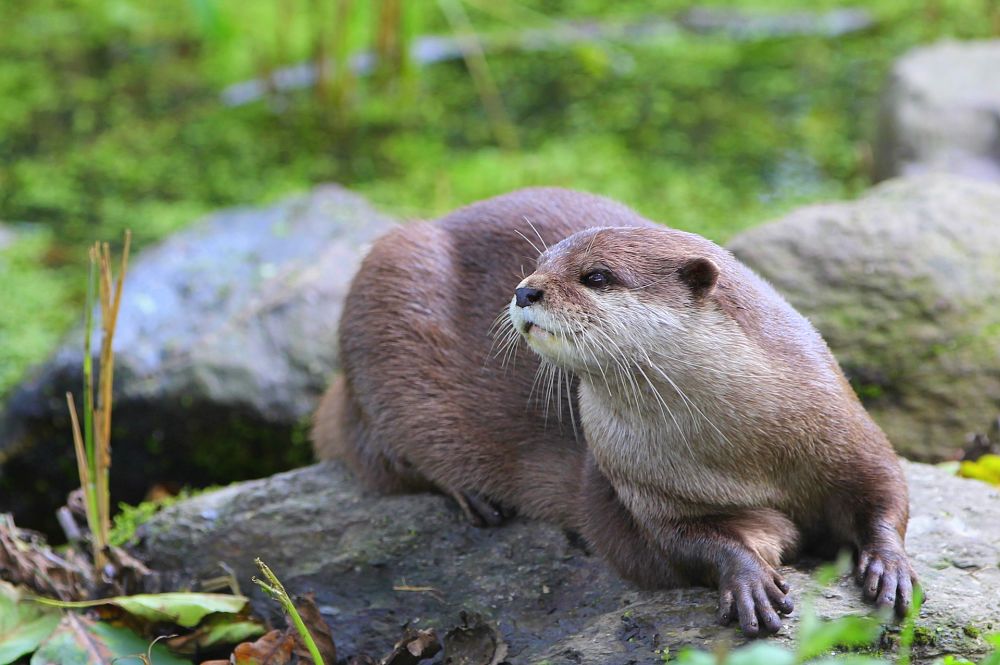
a few more otter facts
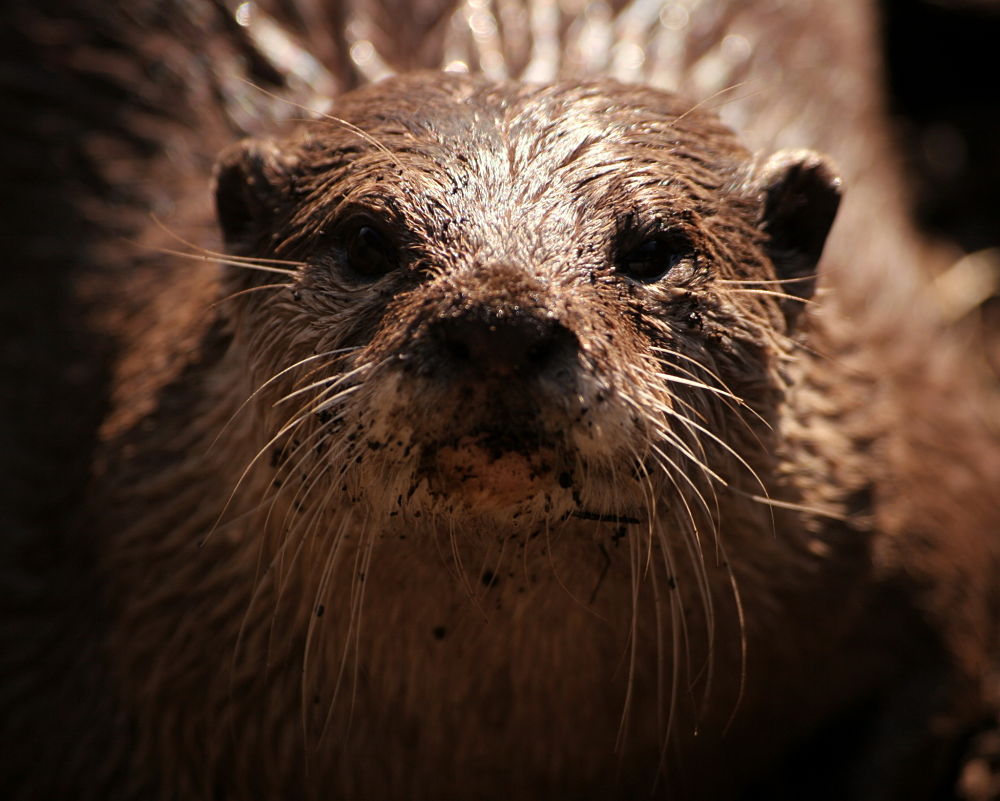
- Giant otters eat piranhas
- River otters love to body surf in the snow
- Mother sea otters wrap their babies in kelp or seaweed while they dive
- Otter poop has its own special name - "spraint"
- The sea otter has the densest coat of any mammal
- Sea otter fur has one million individual hairs per square inch
- Sea otters use rocks as tools to break open clams and crab shells
- The sea otter is the smallest marine mammal
- Fisherman in Bangladesh used trained otters to help them net the catch of the day
Scientific Classification:
| Otter - animalstats - | |||
|---|---|---|---|
| MALE | FEMALE | YOUNG | SOCIAL UNIT |
| boar, dog | sow, bitch | pup, kit, cub | loose groups |
| GROUP | HOME | HABITAT | FAVORITE FOOD |
| bevy,romp | worldwide | river, ocean | fish, clams |
| RIVER OTTER TOP SPEED, AVERAGE SIZE etc. | |||
| 16 mph | 20-40 pounds | 30-46 inches | birth on land |
| RAISED | # OF YOUNG | AT BIRTH | INDEPENDENT |
| mother | 3-5 average | blind, helpless | 1 year |
| SEA OTTER AVG TOP SPEED, AVERAGE SIZE etc. | |||
| 6 mph | 45-75 pounds | 40-52 inches | birth in water |
| RAISED | # OF YOUNG | AT BIRTH | INDEPENDENT |
| mother | 1 rarely 2 | blind, helpless | 8 months |
see more animal extreme closeups
Recent Articles
-
African Animals - Animal Facts Encyclopedia
Oct 11, 16 10:27 PM
African Animals facts photos and videos..Africa is a wonderland for animal lovers, and a schoolroom for anyone who wants to learn about nature, beauty and the rhythm of life -
Baboon Facts - Animal Facts Encyclopedia
Oct 11, 16 10:26 PM
Baboon facts, photos, videos and information - Baboons are very distinctive looking monkeys with long, dog-like snouts and close set eyes. -
Great Apes Facts - Animal Facts Encyclopedia
Oct 11, 16 10:25 PM
Great apes facts, photos and videos..Human beings did not evolve from chimpanzees, modern chimps and gorillas do not appear in the fossil records until much more recently than homo sapiens..




















